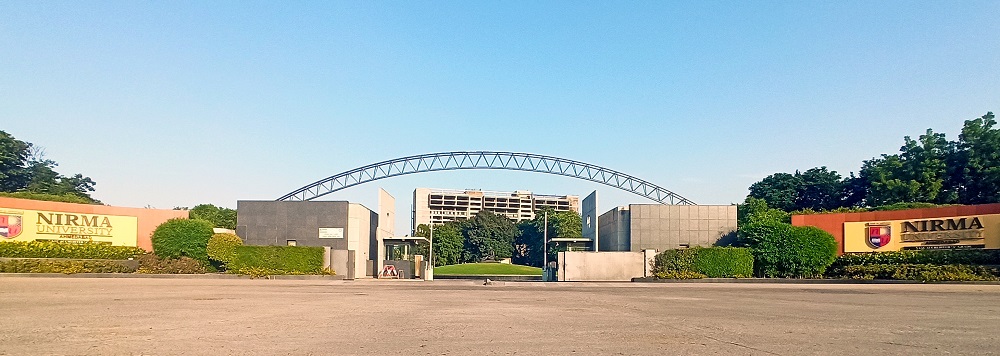
BACKGROUND
Nirma University?s sprawling 115-acre campus features significant flora reserves, well-designed buildings, a herbal garden, a host of playgrounds, and peppered amongst these are 21 monumental sculptures to give shape to the vision of the Nirma University to let students seek inspiration in Art. The natural surroundings provide an opportunity for visitors to visually engage and explore these sculptures at their own leisure.
Twenty one sculptors were engaged to carve out these masterpieces on the university campus. The project, unprecedented in many ways, is aimed to renew societal interest in public art. This is a massive vision, one that has the potential to go beyond the boundaries of the Nirma University.
Workshop curators, Mr Surya Goswami, a senior sculptor, and Mr Atul Padia, an independent Visual Artist mobilised expert sculptors from Nagpur, Mumbai, Haryana, Punjab, Banaras, Udaipur, Thane, Saputara, Ahmedabad, and Vadodara. They traversed mines in search of the right raw materials and picked rocks of 8 different types for carving them into gigantic sculptures. The workshop began on June 8, 2017, with more than 21 participants and 25 helpers equipped with all the necessary rasps and rifflers and ended on June 28, 2017, with hard rock converted into artistic masterpieces.
Sculptures at the Campus
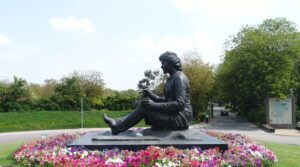
One cannot miss out the Student statue at the entrance of the Nirma University. The statue has been created in Bronze in the year 2015. Weighing approximately 2400 kg, it is 11feet in length, 6 feet in width, and 10 feet in height made by Shri Ratilal Kansodaria (Ahmedabad). It represents a child who is studying.
Saraswati Statue
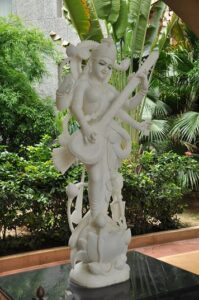
The statue was made by Pandey Moorti Bhandar (Jaipur) from pure white spotless Makrana marble. The height of the statue is 5 feet. One cannot miss out the serene and calm impact it offers as one enters the gates of the Institute of Management, Nirma University. As we all know, Saraswati is a symbol of learning, it is rightly installed at the University, the hub of learning.
Both, these statues and the other sculptures installed later are a part of our learning ambience.
Other Sculptures
THEME
Based on the theme ?Education and Society?, a host of sculptures spread across different locations on the university campus are a visual treat. Each sculpture is distinct and draws a unique perspective on academics within its form. Sculptures ranging from 10 feet to 20 feet high are a symbol of both, traditional and modern art.
Each sculpture displays the life story and geographic influence of the artist, which is miraculous and unique. The Sculptures provide a gateway to a process of self-discovery, enjoyment and learning to the students and visitors, alike. It also allows for social interaction where collective interpretation and reflection can be shared.
The collection showcases a variety of sculptures in sandstone, limestone, Dhrangadhra Sandstone, Dholpur Pink, Jaisalmer Yellow, Kesariyaji Green, and Abu Blackstone, with larger-than-life works of art. It will not be an exaggeration to call it a hidden treasure. These unique sculptures, which are installed at strategic locations throughout the campus, are professionally maintained.
Shri K K Patel, Vice President, Nirma University, shares perspective on the value of art immersed in our environment. He is of the opinion that, Art delights the senses and stimulates the mind. It is one of the hallmarks of a civilised and engaged society. Along with giving voice to human creativity it also beautifies our surroundings. It is for these reasons that the Nirma University prides in hosting these vibrant Sculptures.
CONCEPTS
Some of the concepts on which the sculptures are carved, include Positive energy in human mind, Golden Egg, Gyan Vigyan, Samay Chakra, Growth, Positive environment, Birth, Knowledge, The Guide, Equality, Education, Success, among others.
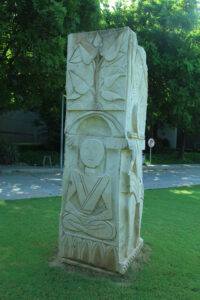
Nandubhai Rathwa worked on the concept ?Gyan Vigyan?. The statue depicts a fine balance between science, technology, humanities and the real world.
It stands for the perseverance and dedication which is required at every stage. The sculpture is placed near the Institute of Law, Nirma University.
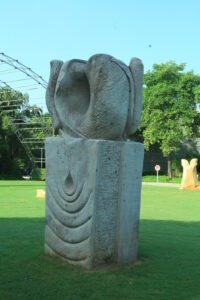
Pardeep Kumar worked on the concept ?Growth?. Fascinated by agriculture he has depicted the seeds sprouting from water in his sculpture.
Here, water stands for one of the elements of life, and seeds are the replica of knowledge. The sculpture is placed in the lawn adjacent to Institute of Management, Nirma University.
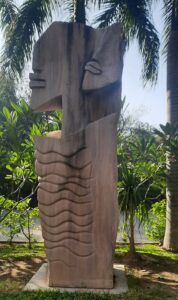
Pradeep Jogdand has worked on the concept ?Untitled?.
He has tried to depict relationships, and complex human behaviour through this sculpture. The sculpture is placed in front of the Nirma University guest house.
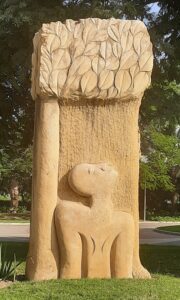
Akash M Bhoya worked on the concept of ?Man Finding Fruit?.
He has been minimalist in his approach. As conveyed by him, ?I play with the spontaneity of thoughts and freedom of medium. I attempt to see the image in the stone and just chip of the extra stone to come out with figure, fruit and tree?. The statue is installed at the entrance of the Institute of Pharmacy, Nirma University.

Durgesh Pawar has aptly worked on the concept of ?Success?. The concept is based on growth and he has used the form of mushroom to execute it.
He has taken inspiration from the fact that just as a mushroom has the ability to grow anywhere after the rainy season, similarly humans can grow and succeed if provided a right environment. And this holds so true not only for the students studying at the university but also the faculty and administrative staff. The statue is installed at the lawn area of Institute of Management, Nirma University.
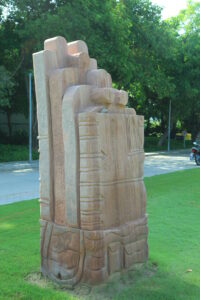
Renu Bala worked on the concept ?Originate?.
Through this piece she has tried to depict a timeline of activities. The sculpture is placed opposite to the PG block, Nirma University.
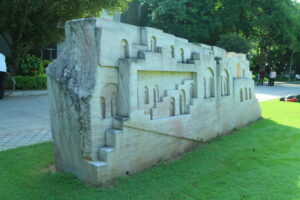
Sangam Vankhade worked on the concept ?Indian Fort?. Inspired by the rich architecture found in the forts of India, he came up with this piece which is installed in front of Institute of Architecture and Planning, Nirma University.
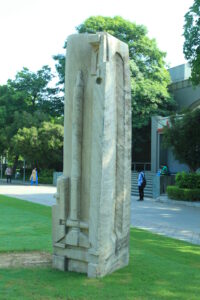
Sanjay R Savaliya worked on the concept ?The Guide?. He has given his piece the form of a pencil. According to him, a pencil can create anything that human mind thinks. Here pencil has a power to guide and lead a person to a better future. The sculpture is placed close to the Institute of Science, Nirma University.
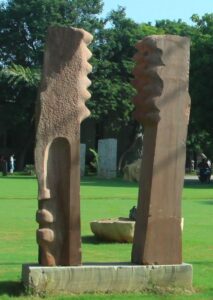
Sunil Kumar worked on the concept ?Me and My Shadow?. The sculptor brings out the facial emotions and feelings almost alive in this sculpture. The sculpture is placed near Institute of Technology, Nirma University.
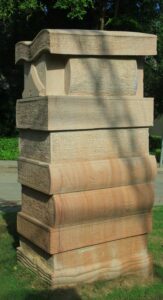
Vipul Raval worked on the concept of ?Education?, a minimalist sculpture displaying a pile of books which are so much an integral part of the education system. The sculpture is placed in one of the university lawn areas.
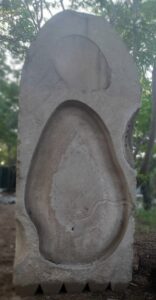
Krishna Padiya has worked on the concept ?Source?. As visualized by him, the world came into existence from the Golden Egg. And this egg symbolizes life. And Nirma University is an apt example of infusing new life into its students. The statue is placed near the University building.
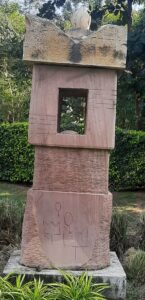
Namdev Kakade worked on the concept of ?Bud and Lotus?. He has tried to capture the scenic beauty of the university, and bring out its details in the form of this sculpture. The statue is placed near the Institute of Management, Nirma University.
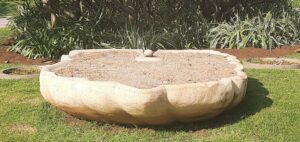
Nandini Hambire worked on the concept ?Nature is Life?. She sought inspiration from the university?s lotus pond and captured the water drop on the lotus leaf in her sculpture. The dew drop on the lotus showcases the importance of a student at the place where he/she is stationed. The sculpture is placed in front of Institute of Management, Nirma University.
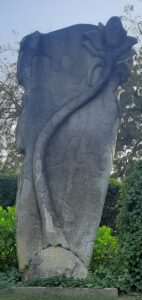
Nikhil S Bonde seeked inspiration from the flora and fauna at Nirma University and worked on the theme ?Sewali?, a flower found abundantly in Assam. The mythological story reveals that it is a heavenly tree brought to earth by Lord Krishna. It is commonly known as a night-jasmine and have seven to eight petals arranged on an orangish-red stem. These beautiful flowers are used in many spiritual activities. The sculpture is placed in the lawn adjacent to Institute of Architecture and Planning, Nirma University.
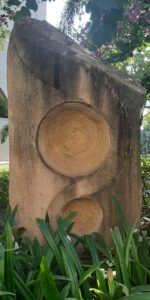
Rahul L Meshram has worked on the concept ?Three Stages of Life?. He has worked on Circle as a form and represented his thoughts through textures.
The depth in the circle adds to the different facets which life offers us. The sculpture is placed in front of the Students? Hostel.